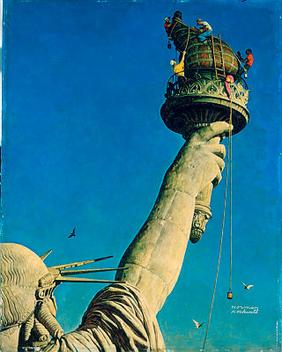- The painting in 2009, at right, near the Resolute desk, above Frederic Remington's sculpture The Bronco Buster
- The painting in 2015, hung above a bust of Martin Luther King by Charles Alston
- The painting in November 2016, seen during a meeting of President Obama and President-elect Trump
| Working on the Statue of Liberty (Statue of Liberty) | |
|---|---|
 | |
| Artist | Norman Rockwell |
| Year | 1946 |
| Medium | Oil on canvas |
| Dimensions | 54.61 cm× 43.02 cm(211⁄2 in× 1615⁄16 in) |
| Location | White House |
Working on the Statue of Liberty, also known as Statue of Liberty, is a 1946 oil painting by American illustrator Norman Rockwell, showing workmen cleaning the torch held aloft by the Statue of Liberty (Liberty Enlightening the World) in New York Harbor. [1]



